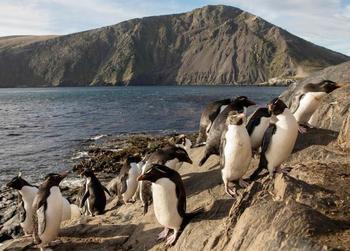
BUENOS AIRES, Argentina, December 13, 2018 (ENS) – Argentina has created two new massive offshore marine parks in the southwest Atlantic that will help protect habitat and feeding grounds for penguins, sea lions, fur seals, sharks, cold-water corals, and many other marine species found nowhere else on Earth.
The two marine parks – Yaganes and Namuncurá-Burdwood Bank II – were officially established in the Patagonian Sea this month by the Argentine Congress, first with a unanimous vote in favor of their creation from House of Representatives on December 5 and then with Wednesday’s vote in the Senate.

Both marine parks are located in a zone of transition between temperate and sub-Antarctic waters. Cold-water currents meeting the submerged banks rising up from deeper waters create highly productive marine environments that, in turn, support enormous biodiversity.
The new marine parks cover a combined area of 85,000 square kilometers (32,818 square miles).
“These new areas represent an achievement of the processes of democratic debate, as well as a significant benefit for conservation,” said Wildlife Conservation Society marine scientist Dr. Claudio Campagna, director of WCS’s Patagonian Sea and Sky Project and president of the Forum for the Conservation of the Patagonian Sea, a consortium of regional NGOs created in 2004.
“Parks of sea and sky in which an immense quantity of penguins and albatrosses, wolves and marine elephants, sharks, rays, cold corals and many other species, will be able to fulfill their life cycles in peace and as nature mandates,” said Campagna.
The Argentine organizations that make up the Forum for the Conservation of the Patagonian Sea are grateful to the provincial and national authorities for their work for the common good,” reflected Campagna.
The Forum has indicated that its member organizations “…will continue working so that the system incorporates other sites of high conservation value, where it is focused on threatened species or in the presence of productive fronts of high diversity. There are key areas in the center and north of our sea, and at the edge of the slope, where human activities are intense, requiring urgent attention.”

The Forum said in a statement, “Although we are encouraged by the increase in the number and area of marine protected areas, it is necessary to achieve representativeness to create a true System that encompasses diversity of species and habitats and connects the ecosystems that we seek to protect.”
The creation of the two marine parks expands the total surface area of Argentina’s protected ocean from 2.6 to eight percent of their sea, bringing the country closer to achieving its international commitments under the Sustainable Development Goals of the United Nations and the Aichi Targets under the Convention on Biological Diversity.
The Aichi Targets recommend that countries work to safeguard 10 percent of their marine and coastal areas by 2020.
“Argentina’s new marine parks are a significant step toward the preservation of the ocean and the diversity of ocean-dependent species in the Patagonian Sea,” said Campagna. “These parks will permit marine wildlife to pursue their life cycles undisturbed.”
WCS’s Patagonian Sea and Sky Project was launched in 2004 as an initiative that advocated a previously daring concept: marine conservation through the protection of large, ecologically important swaths of marine habitat in open-ocean parks.
Over time, the project has garnered support through the Forum and the Argentine Government, particularly the National Parks Agency, the Secretary of the Environment and Sustainable Development, and the Ministry of Science, with its program called Pampa Azul.
Working together with researchers in Argentina’s National Scientific and Technical Research Council, Consejo Nacional de Investigaciones Científicas y Técnicas, CONICET, the New York-based Wildlife Conservation Society helped to create the concept and gather the needed baseline data for the creation of Argentina’s new marine parks.

Previous successes include the creation of the country’s first Marine Protected Area, Namuncurá-Burdwood Bank I, in 2013.
The work has been supported by WCS’s Marine Protected Area Fund, launched in 2016, with a goal of establishing new protections for more than one million square kilometers of unprotected ocean by 2020.
Technical support from WCS and other organizations has been a key factor in helping to build support for turning Yaganes and Namuncurá-Burdwood Bank II into marine parks. WCS worked in collaboration with the Forum for the Conservation of the Patagonian Sea in a two-year project to advance the goal of creating these new open ocean Marine Protection Areas.
“The creation of these parks is the result of years of passion and hard work by many people and partners with a common objective: to conserve the ocean environments,” said Carina Righi, director of WCS’s Argentina Program.
WCS has worked to protect the wildlife and wild lands of coastal Patagonia since the 1970s, beginning with long-running studies on southern right whales, Magellanic penguins, elephant seals, and sea lions.
WCS-led research on coastal marine species has been conducted in tandem with efforts to promote a growing tourism industry that creates awareness and appreciation of these spectacular wildlife gatherings.
Copyright Environment News Service (ENS) 2018. All rights reserved.
© 2018, Environment News Service. All rights reserved. Content may be quoted only with proper attribution and a direct link to the original article. Full reproduction is prohibited.
